#Meteor JS Developer
Explore tagged Tumblr posts
Text
#dapl#digital aptech#react.js#reactjs#vuejs#angular js#meteor#web developers#web development#app developers#app development
1 note
·
View note
Text
Exploring Innovation: An Comprehensive Guide of Assimilate Technologies' Mobile App Development
In the ever-changing digital world of today, mobile app development is essential to turning concepts into creative solutions. One key player in the IT sector is Assimilate Technologies, which is particularly strong in the field of developing mobile applications. We'll dive into the realm of mobile app development in this blog article and examine how Assimilate Technologies is transforming it.
Understanding How to Develop Mobile Apps:
The process of developing software specifically for mobile devices, such tablets and smartphones, is known as mobile app development. These applications have a variety of uses, from social networking and entertainment to productivity and commercial solutions. Idea generation, design, development, testing, and deployment are all included in the process, which aims to provide an outstanding user experience.

Why Choose Assimilate Technologies?
Support: Fast, complete ITSM assistance.
Expertise: Dedicated project experts are available at all times.
Development: For quicker launch, use specialized mobile app developers.
Approach: A flexible approach that takes into account recommendations for improvement.
Pricing: Reasonably priced.
Benefits of Mobile App Development:
Direct and fast connectivity with customers.
24-hrs marketing channel with a personalized communication facility.
Brand strengthening and increased awareness about the new offerings.
Fostered loyalty and strengthened relationships.
Improvement in leads generation and conversion rate
Improved and easy-to-customer support.
Convenient Mobile App Development Services for Android & iOS:
We offer reasonably cost services for mobile app development, management, and maintenance as a top mobile app consultant and specialists. Our developed technical ability and results-driven, reasonably priced mobile app development solutions take care of your specific needs.
Design UI and UX of mobile apps.
Design, development, integration, update, and management consultancy for mobile apps.
Mobile app QA and testing.
Mobile application redesign.
Helping hands for the mobile application to run smoothly.

Experience in Top Frameworks for Mobile App Development:
At Assimilate Technologies, enhancing tech-specific knowledge and expanding the range of services offered have become organizational ideologies. We are very skilled in utilizing the most recent frameworks and technologies for developing mobile apps, including Angular JS, Xamarin, Swiftic, Meteor, Flutter, React Native, Native Script and many more.
Conclusion:
When it comes to creativity and dependability in the constantly changing field of mobile app development, Assimilate Technologies is a shining example. The dedication to providing customized solutions, along with their proficient team and customer-focused methodology, establish them as a top option for companies looking for superior mobile app development. Assimilate Technologies is the partner you can rely on to realize your vision for a game-changing app for your company. For more; https://bit.ly/3O8qE8C
About us:
As a top technology consulting firm, Assimilate Technologies is passionate about finding straightforward answers to complex issues. Assimilate was founded by a motivated, enthusiastic group of technophiles who wanted to use straightforward technology to address issues in the real world.
Assimilate Technologies Pvt Ltd | India | USA | https://assimilatetechnologies.com [email protected]
+91 88888 99151 | +1 860 251 9229
0 notes
Text
Nodejs Development | Node js Developers | Node js Developer

Nodejs development is a popular choice for erecting scalable and high-performance web operations using JavaScript on the garçon side. Nodejs Development provides a runtime terrain that enables a Nodejs inventor to make presto and effective web operations with event-driven and non-blocking I/ O operations. With its robust set of libraries and modules, Nodejs development allows inventors to make web operations for colorful disciplines, including eCommerce, real-time operations, and streaming services. Nodejs development also offers flawless integration with frontal-end fabrics similar to Angular, Reply, and Vue, enabling Nodejs inventors to make full-mound web operations using a single programming language. Nodejs inventors also have experience working with colorful databases, including MongoDB, MySQL, and PostgreSQL, and use their knowledge to make web operations that bear data operation. Overall, Nodejs development provides inventors with the inflexibility, scalability, and effectiveness demanded to make innovative and high-quality web operations.
Service Immolations: Event-driven Node.js web operations. tailoredNode.js development services. Development of plugins and doors for colorful operations. Real-time business operations usingNode.js SaaS- grounded product development and conservation. gyms, E-commerce operations and APIs.
Framework Competency: JavaScript has gained significant significance in the programming world with the arrival of Node.js. Since it was formerly an extensively used programming language in cybersurfers, it was ineluctable that it would find its way into garçon- side perpetration. This eliminates the need for inventors to use two different languages on both ends and simplifies the development process.
offers innovative results for erecting waiters and web/ mobile operations. Its single-threaded event looping and asynchronous,non-blocking input/ affair processing point sets it piecemeal from other runtime surroundings. It's fleetly expanding with benefactions from the inventor community and other technology titans. multitudinous performance-driven fabrics have been developed grounded on Node.js's primary principles and approaches, extending its functionality and introducing new features.
fabrics likeExpress.js andHapi.js are gaining fashionability among inventors for erecting better websites and mobile operations. thus, it's essential to keep up with the rearmost inventions in the tech world that these Node.js fabrics bring. As a result, we've collected a list of the top 10 Node.js fabrics that are presently reconsidering the operation development field. Hapi.js Socket.io Express.js Mojito Meteor Derby Mean.js Sails.js Koa.js Total.js
Tools & Technologies: Mocha.js Chai Sinon.JS Express.js WebStrom IDE Passport.js Socket.io Webpack BlueBird.js
FOR MORE DETAILS DO VISIT- DCS
0 notes
Text
We are a prominent Meteor js Development Company in the USA offering a comprehensive range of Meteor js applications development services for reliable and secure hybrid applications.
0 notes
Link
1 note
·
View note
Text
NodeJS Development: Analyzing the Good and the Bad
Introduction: Node.js is a server-side development platform made on Google Chrome's JavaScript V8 Engine, which is known for its flawless adaptability. NodeJS is mainstream among web designers and a predictable piece of web development innovation stacks like MEAN and MERN. In this article, we will survey the advantages and disadvantages of NodeJS development.
Albeit utilized essentially for service side programming, NodeJS offers extra highlights. It's neither a library nor a system, however, an extensive run time climate committed to service side applications.
NodeJS is a programming language, which permits designers to compose code both front-end and back-end code for service side applications. The stage is received by probably the greatest organizations on the lookout, including monsters like Twitter, NASA, and Walmart. It is ideal for building versatile and proficient REST APIs. Nonetheless, numerous designers additionally use NodeJS to fabricate an assortment of arrangements, including crossbreed portable applications, the Internet of Things, and work area applications. Two highlights hang out in NodeJS development the most, specifically, its occasion-driven nature and non-obstructing I/O model. Both these highlights establish the framework for NodeJS's effective, lightweight, and quick arrangement.

Advantages of NodeJS
• Easy Scalability • Easy to Learn • Highly Extensible • High Performance • Support For JSON • Optimized For JavaScript • Full-Stack JavaScript • Used as a Single Programming Language • Support of Large and Active Community • Handles the Requests Simultaneously • Powered By Google Chrome • Cross-Platform Applications
Disadvantages of NodeJS
• Heavy Computing Tasks Affect Performance • Application Programming Interface (API) is Not Stable • Paradoxically Harder to Maintain • Does not have a Strong Library Support System • Asynchronous Programming Model
Node.js Frameworks and Tools • AdonisJs • Egg.js • Express • Fastify • Gatsby • hapi • koa • Loopback.io • Meteor • Micro • NestJS • Next.js • Nx • Sapper • Socket.io • Strapi
People also ask about Node.js Web App Development:
What is node js used for?
Node. js is primarily used for non-blocking, event-driven servers, due to its single-threaded nature. It's used for traditional web-sites and back-end API services, but was designed with real-time, push-based architectures in mind.
What is Node.js used for?
Node.js is primarily used for non-blocking, event-driven servers, due to its single-threaded nature. It's used for traditional web sites and back-end API services but was designed with real-time, push-based architectures in mind.
Hire Our Node.js Developers & Node Js Development services to Create Quality Solution
#Nodejs Development#hire nodejs developer#hire node.js development company#nodejs development services
1 note
·
View note
Text
List of Top JavaScript Frameworks 2020 For Front End Development
JavaScript is defining the future of the tech world with its wide genre of competent frameworks, which are capable of accelerating the development of applications in many ways. How to choose a certain framework in JavaScript is based on the company’s goals, project requirements and how certain frameworks can be used in different scenarios.
JavaScript, one of the most surreal and beautiful programming languages, enwrapped by the intriguing fact that even though it is named “Java” Script, it doesn’t have any association with Java. In mid-1995, when JavaScript came into existence it was disguised as the name Mocha and later it was named as “LiveScript” and when Netscape and Sun did a license agreement it was finally renamed to “JavaScript”. Nobody had even imagined in its initial form that it would be such a revolutionary programming language and would be entitled as one of the major languages to learn. The world is pacing fast with the ever-changing technology and programming languages being the pillar of technology. JavaScript is surely defining the future with its compelling and competent frameworks.
What are the Frameworks?
In general, a framework is a prototype or conceptual structure intended to serve as a support or guide for the building of something that expands the structure into something useful. According to Wikipedia ” A software framework is an abstraction in which software providing generic functionality can be selectively changed by additional user-written code, thus providing application-specific software.”
JavaScript web frameworks are cheat codes for quick web application development. They serve as a skeletal frame for single page application development and allows developers to worry less about code structure or maintenance and help them in focusing more on the creation of complex interface elements and expand opportunities of JS and plain HTML.
So, Which frameworks of JavaScript are most popular and why?
Below is the list of a few Javascript frameworks:
1. AngularJS- AngularJS is an open-source framework used in frontend and is maintained by Google. It is mainly used to subside and sort the problems encountered while creating single-page applications usually have, as it simplifies both development and testing of such application by providing a framework for client-side model view controller (MVC) and model view-view model (MVVM) architectures. For now, it is known to be the most used JavaScript framework for single-page applications and have the largest community of developers.
2. ReactJS- ReactJS camouflage itself to be JS framework but it is more of an open-source JS library, which has huge names like Facebook and Instagram behind it. React was built by a software engineer at Facebook. In 2011, it was first deployed on Facebook’s newsfeed and later on Instagram in 2012. React Js emerges in an ecosystem of complete frameworks, but it’s just the view. In MVC(Mobile-View-Controller) pattern, React.js acts as “V” and can be smoothly integrated with any architecture.
A fully functional dynamic application can’t be built with React alone. Recently, On April 18th 2017, Facebook announced a new core algorithm of React framework library for building user interface named React Fiber, which is said to be the foundation for future development and improvement of ReactJS.
3. Ember JS- A few years back, in 2015, EmberJs was considered to be the best framework leaving React and AngularJS behind. It does two-way data binding as same as AngularJS keeping both view and model in sync for all the time. Emberjs is commonly used for complex feature-rich web applications and website. LinkedIn, Netflix, Chipotle, Blue Apron, Nordstrom are one of the few of the top names that have incorporated EmberJS.
What works in its favour is that it is easy to learn and have many tutorials online which helps to learn it with ease.
4. Vue.Js- Vue.js is considered to be one of the best solutions for cross-platform development. The development of Vue.Js is considered by taking the best qualities from Angular, React and Ember such as Vue.js offers two-way data binding (same as in AngularJS), server-side rendering (like in Angular2 and ReactJS), Vue-CLI (backbone tool for quick start) and optional JSX support. and all the altering flaws in prior three.
5. MeteorJS- MeteorJS is a free and open-source framework, which is well-equipped with tons of features for back-end development, front-end rendering, DB(database) management and business logic. Being a full-stack platform, it has the quality that its name suggests which is being fast. If you’re looking to rapidly develop smaller, reactive applications on the Node.js platform, Meteor is definitely an excellent choice.
Due to its modular structure, all the packages and libraries can be used at a high pace. In terms of performance, all the changes in the database are transmitted to the UI in the shortest time possible and in conversely with no evident time losses caused by different languages or server response time.
The consideration of a JavaScript framework is based on the company’s goals, project requirements and how certain frameworks can be used in certain scenarios. JavaScript is portraying the whole new depiction of the future of technology as it backs the prompt development and prototyping.
These frameworks and libraries have already reshaped the way how JS collaborates with HTML and CSS to compile views both in browsers and now even on native platforms.
#java script framework#javascript framework development#javascript development 2020#website development company
2 notes
·
View notes
Text
What is the future of AngularJS?
AngularJS has undergone significant improvements between its models and has changed significantly for the better. There's been a change in every single react over Angular js. The experimental MVC framework has now become a stable platform which is well supported. The focus of Angular JS is on easy and popular browsers such as Chrome, Firefox, Opera, Internet Explorer 8, Linux, iOS6 +, etc That helps to maintain Angular's codebase low when promoting the new functionality with no backward compatibility stress. Thanks to its functionality, AngularJS immediately began to dominate every conversation about the JavaScript-related framework. Perhaps the fact that Google made Angular makes it a better option for users now and in the years to come, but one can never foresee the success of the new frameworks that could pop up in years. Right now, only the big businesses want to go Angular way more as it combines seamlessly with other systems such as Telerik's Kendo UI, Ionic, Wijmo and others.
Scope of AngularJs:
Angular JS is currently one of the excellent frameworks. Significant growth in the area of Software apps and Web creation is expected in the coming days. Most of India's Career portal sites have said several businesses are ready to hire angular js developers with knowledge of Angular JS frameworks. It is also claimed that the Angular2 version is primarily used by many angular js developers in the area of IT. Therefore, this is one of the reasons for Angular JS's variety. AngularJS Course aims you learn the ideal platform for creating new interactive mobile apps. Micro, medium, and large size businesses use Angular JS applications to fund their programs. Angular JS Developers' work prospects and variety are high and one can improve their career by entering Angular JS Learning and technical learning of the course. The developers struggle with a lot of a framework in the case of a front end. The choice of a variety of javascript frameworks depends entirely on our needs. For example, if customer-side lightweight execution is needed, one should go for js in the backend. Similarly, a developer can opt for meteor js for single page use. Yet such systems such as backbone js, meteor js only serve certain unique requirements, which is why angular is a bit different when opposed to all other JavaScript frames. This can provide consumers with various criteria, such as, with it, we can build a single page document, it can be used for lightweight execution and it can be used to deliver an optimal solution. So we may claim that angular js has a wide potential in the area because of its advanced technology.
1 note
·
View note
Video
tumblr
The technology is improving so quickly. Expertise at Rhobos IT Solutions is master in different trending technologies such as understanding of different Browsers like Google Chrome, Safari, Firefox, Opera, Internet Explorer. Knowledgeable in HTML and CSS languages, an expert in different web development frameworks like Angular, Ruby on Rails, YII, Meteor JS, Express.js, Zend, Django, Laravel, etc. Except that they are familiar using different programming languages such as Javascript, CoffeeScript, Python, Ruby, PHP, Go, Java, etc. They nows excellent use of different protocols such as HTTP, DDP, REST, etc. The endpoints are exposed by the developers while the API can control access with an API key. To stay up to date with the latest web technologies, Rhobos IT Solutions helps its employees to learn new things all the time.
#SEO services in Durgapur#software companies in Durgapur#bestITcompanyindurgapur bestWebdevelopmentcompanyindurgapur bestsoftwaredevelopmentcompanyindurgapur webdesigner#Digital Marketing Company in Durgapur#SoftwareCompanyinDurgapur
1 note
·
View note
Text
JavaScript Usage by Industry
We’re continuing our analysis of the results of last winter’s JavaScript Ecosystem Survey, a survey of over 16,000 developers conducted by npm in collaboration with the Node.JS Foundation and the JS Foundation. Our second topic is How JavaScript is used across industries — and, more specifically, how different industries use certain JavaScript tools, frameworks, and practices. To read more about the methodology behind this survey, click here.
We asked about what industry our respondents worked in. 45% of users answered “tech”, revealing an underlying ambiguity in our question. For instance, if you work at Google, do you work at a tech company or an advertising company? What about at Microsoft, which many consider a tech company, but also has advertising and even hardware manufacturing arms? Next time, we’ll ask for more detailed information about industry concentrations.
“We asked about what industry our respondents worked in. The most common answer was “tech” at 45%”
Despite this, we still gathered some good data about how use of JavaScript varies by industry. The top industries were:
finance: 7%
advertising and marketing: 5%
education: 5%
entertainment: 5%
business support and logistics: 4%
healthcare: 4%
retail: 3%
government: 2%
manufacturing: 2%
There were meaningful differences across industries in how and why people use JavaScript. There were also some clear commonalities, not all of which we’re going to mention. But from a statistician’s point of view, the questions where all the industries answered very similarly are useful because it indicates the differences in other questions are “real” and not just random variation.
With 16,000 responses, even the single-digit groups per industry constituted enough data to make meaningful conclusions. We discarded answers from industries with less than 2% responses (i.e. less than 300 individual responses).
JavaScript tools
First, we asked about common tools: bundlers, linters, testing frameworks, transpilers, CSS preprocessors, and more.
Manufacturing across the board uses less of everything — only 51% of manufacturing respondents say they use a testing framework, compared to 75% in finance.
The explanation for this may lie in the answer to another question; “Where does the JavaScript you write run?” 15% of manufacturing developers say their code runs on embedded devices which is twice as much as any other industry. Embedded platforms often have intrinsic transpilers for JS, so you do not need to use your own and have no need for browser-specific optimizations that most of these tools provide.
“Manufacturing across the board uses less of everything — only 51% of manufacturing respondents say they use a testing framework, compared to 75% in finance.”
Put another way: hardware isn’t a browser. This view of manufacturing respondents is backed up by another question, in which 31% of manufacturing respondents say their code is put to use in IoT (Internet of Things). No other industry gets above double digits for that answer. This makes manufacturing an interesting set of answers across the board, as we’ll see.
Finance, on the other hand, uses everything the most. They are the most likely to use a bundler, second-most likely to use a linter (after healthcare), most likely to test, second-most likely to use a web framework (after retail), most likely to use a transpiler, and second-most likely to use a CSS preprocessor (after advertising). Finance just does all the things.
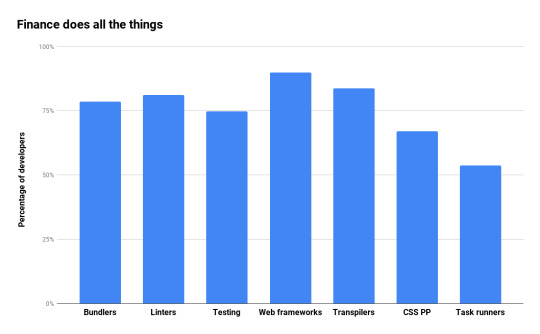
JavaScript frameworks
We’ve examined the popularity of JavaScript frameworks in the past. Our survey data provides another view into these preferences, and the results are enlightening.
Angular was a fairly popular choice across all industries, but strongest in finance. Developers in entertainment were the least likely to use Angular, their strongest preference being for React (65%).
React was the most popular framework in the survey overall, though with strong variations by industry. As mentioned, 65% of developers in entertainment chose it, but that fell to 46% in government and 38% in manufacturing. Manufacturing’s strongest choice for a framework was jQuery (52%), suggesting the industry is a late adopter. Government also had jQuery as its top pick at 52%.
Around 20% of developers in most industries reported using Vue, though it was notably more popular in advertising, with 34% of developers reporting it there.
“We also asked developers how they made decisions about choosing frameworks. Big majorities (60-90%) in every industry reported things like support, features, and stability being important, with little variation.”
Ember did not get a lot of mention from our respondents, with an average of 4% of developers reporting that they used it. Also in this range were Preact (5%), Hapi (5%), Next.js (5%), and Meteor (5%).
A surprisingly popular choice was Electron, which is obviously not a web framework at all but we included in our options. More than 20% of developers in every industry reported using Electron for some projects.
We also asked developers how they made decisions about choosing frameworks. Big majorities (60-90%) in every industry reported things like support, features, and stability being important, with little variation. Security was the lowest ranked concern for frameworks, averaging only 25%, though finance was most concerned at 30%. We’ll go more into attitudes to security later in this post.
Language choices
Obviously everybody in the survey uses JavaScript, but lots of respondents use another primary language as their back-end choice and there were noticeable variations by category.
Python was the choice of the unemployed. This sounds unflattering, but thanks to a poorly-phrased question on our part, the “unemployed” category includes people in full time education. Their questions (such as what level of schooling the respondent had completed) lend weight to the idea that the unemployed category was full of people who are still in school, so we believe Python is popular in education.
Java was the choice of the finance industry by quite a margin—41% versus 27% for the second most popular language in finance, .NET.
PHP was the choice of the advertising industry, again by a huge margin — 49% to 26% for Python, the second most popular. Why advertising companies choose PHP is unclear to us, but PHP is popular with advertising agencies putting together micro-sites. Furthermore, a question about company size showed that over 50% of advertising respondents worked at small companies (less than 50 people), so this category is probably dominated by small shops putting together these sorts of sites.
Our poorly-chosen “.NET” category (not really a language) was no industry’s first choice. Its strongest showing was in the manufacturing category at 33%, a very close second to Python at 34%. However, because we didn’t pick out C# and F# separately, it’s possible these results are skewed by people who use those languages, but don’t use .NET.
Ruby is a relatively unpopular option across all our respondents, chosen by less than 13% in all cases. Its weakest showing was in manufacturing, where only 3% chose it, and its strongest in education, where 13% did.
C and C++ were unsurprisingly most popular in the hardware-dominated manufacturing industry, at 9% and 18% of respondents respectively. C++ was more popular than C across the board. The retail industry is the least fond of C++, with only 4% of respondents reporting using it.
We also polled on Go, Swift, and Rust. Go was about 10% usage across the board, Swift was 3-5%, and Rust about 3% except in manufacturing, where it hit 7%.
Why do you choose JavaScript?
In general, people are pretty clear why they choose JavaScript: the huge ecosystem of libraries. An academic study of the same topic in 2013, An Empirical Analysis of Programming Language Choices (Meyerovich and Rabkin, 2013) exhaustively researched what makes developers choose programming languages and it reached the same conclusion. It’s not controversial to conclude that the modules in the npm registry are a major reason people choose JavaScript. However, people cited a number of other reasons and there were notable variations by industry.
Respondents who say they work in government were the least likely to report that they chose JavaScript for productivity gains, with only 51% saying so versus 60% in the finance industry, where this belief is strongest. Instead, government was most likely to believe that using JavaScript gave them performance gains: 31% of government respondents cite this, while in most other industries only 20-21% said this.
The advertising industry is the one most likely to say that developer satisfaction is a reason they choose to use JavaScript, with 50% of respondents saying so. This is notable since the advertising industry has a lot of PHP developers, and as we’ll see in a future analysis based on programming language choices, high satisfaction with JavaScript is a characteristic shared by most PHP developers.
“Across every industry, solid majorities (more than 90% in every case) expected to use JavaScript more or about the same amount as they had previously in the next 12 months.”
Cost savings as a reason for choosing JavaScript were most cited by respondents who work in finance (41%). This seems pretty logical, as finance is an industry that presumably can be relied upon to think of the costs of things.
The entertainment industry was the most likely to cite the size of the developer pool (41%) while the retail industry was most likely to say the ease of on-boarding new developers (40%) was their reason for choosing JavaScript. While JavaScript has a big pool of developers and we think on-boarding developers in JavaScript is pretty easy, it’s unclear why these industries in particular would note those advantages.
Finally, some people don’t get to choose what programming language they work in. This number was highest in government, at 21%.
Across every industry, solid majorities (more than 90% in every case) expected to use JavaScript more or about the same amount as they had previously in the next 12 months.
Attitudes to security
npm is making a big push to improve the security of the modules in the registry in 2018, so we asked our users about their attitudes toward security. You can see our previous post for a deeper analysis of attitudes to security, but there are some interesting variations by industry.
Firstly, everyone is concerned about the security of the code they write (87-90%) and of the open source code they use (73-79%). Developers who work in tech were the most likely to be concerned, but there wasn’t a lot of variation.
Majorities in every industry reported that they were dissatisfied with current methods of evaluating the security of code (51-60%). Advertising and entertainment were the most likely to say they were dissatisfied with available methods.
“Firstly, everyone is concerned about the security of the code they write (87-90%) and of the open source code they use (73-79%). Developers who work in tech were the most likely to be concerned, but there wasn’t a lot of variation.”
A whopping 90% of people working in education (non-students) were likely to be concerned about the quality of the code they wrote themselves. This was an interesting result as they were also the industry most likely to say they were doing nothing at all to assess security (33%):

The industry most likely to be actively doing something about security is the finance industry. They were the group most likely to participate in code reviews (81%), most likely to have external audits of their code (30%), and the most likely to be using automated scans of their code (52%). The tech industry was a close second to finance in all of these answers.
Private code
We explored the ways developers use and store private code.
Everybody reports having private code and GitHub is an extremely popular place to store it — 93% of the advertising industry report using it, with most industries in the high 80’s. Manufacturing was an outlier here, with only 75% of developers saying they used GitHub. We thought this was a strange result, but it was consistent; when asked how they discovered packages, developers in manufacturing were also the least likely to report using GitHub (14% versus 20% for other groups).
Developers also store private npm packages. Across all industries, about a third of developers said they had created private npm packages. However, their reasons for doing so varied.
“However, by far the most popular reason for everyone using private packages was the most obvious: the packages contain private IP. Majorities from 65% in education to 91% in manufacturing reported this as a reason for creating private npm packages.”
Developers sometimes use private modules to hold test projects which aren’t ready for release. This practice varies widely across industries, with 23% of developers in education saying they do this but only 8% in retail.
More common was keeping code private for release as open source later. Education was likely to do this, with 27% saying so, and government employees following close behind at 25%. Healthcare developers, who reported less engagement with open source, were the least likely to report this as a reason, at 9%.
A big reason for everyone to keep private packages was re-use by their co-workers — including majorities from 53% in finance and 67% in retail.
However, by far the biggest reason for everyone using private packages was the most obvious: the packages contain private IP. Majorities from 65% in education to 91% in manufacturing reported this as a reason for creating private npm packages.
Testing
Finally, we explored attitudes toward testing across the industries.
In keeping with its answers in every other category, finance was the most likely to report that they use a testing framework (88%). Government and manufacturing developers on the other hand were the least likely to use a testing framework, with only 68% of developers in both industries saying so.
Across every industry, the most popular testing framework choice was Mocha (50%), followed by Jasmine (33%) and Jest (19%). Unlike web framework choices, there was less variation between the popularity of testing frameworks across industries.
Conclusions
There were some fascinating differences across the industries. The advertising and entertainment industries often found themselves paired together in terms of practices. Finance was cautious and security-focused. Government and manufacturing were mostly on the opposite end of that scale, with lower reported use of best practices and modern tooling. Whether you’re in these industries or building products for developers in these industries, we hope these results help you get a better sense of the broader universe of JavaScript developers.
Thanks to everyone who took the survey. We’ll be providing more analysis in the near future, so stay tuned!
190 notes
·
View notes
Text

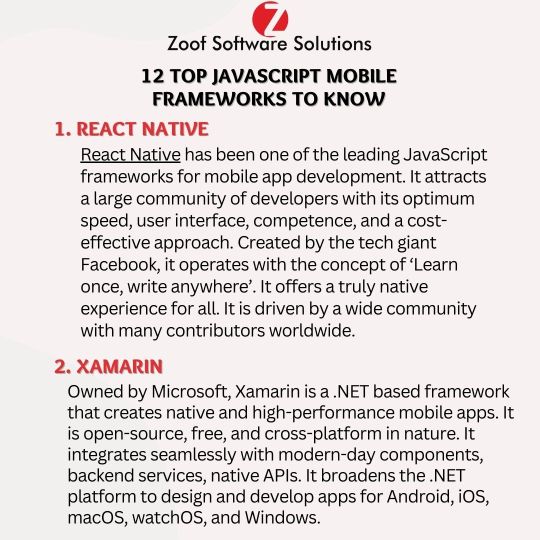
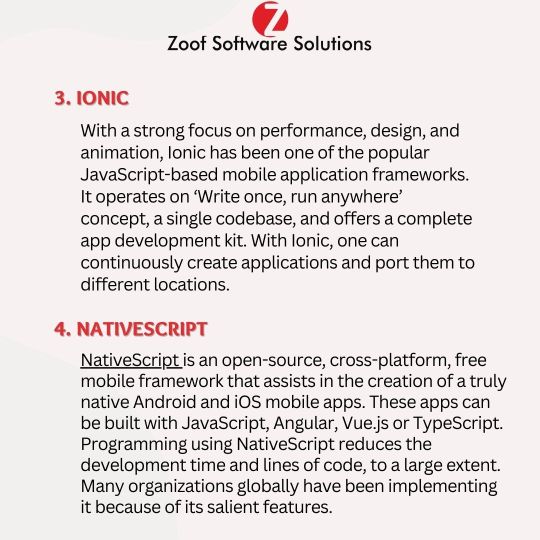
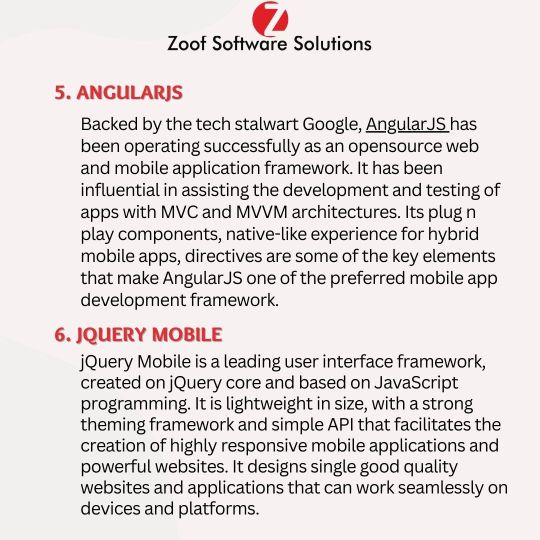

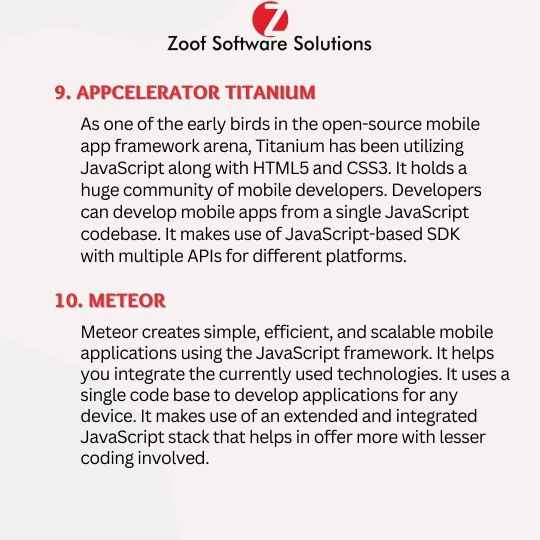
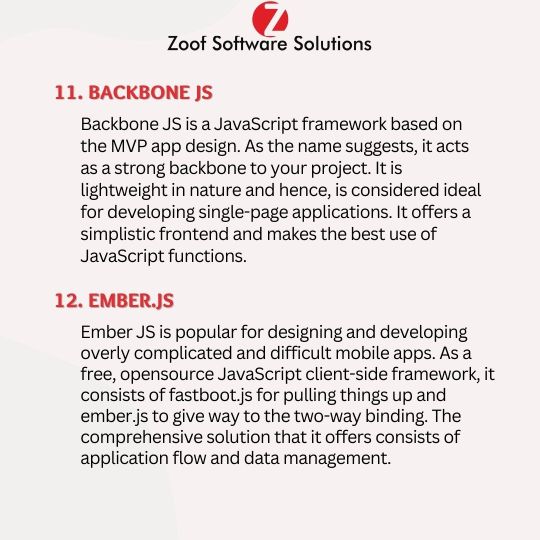
12 Top JavaScript Mobile Frameworks To Know
JavaScript mobile frameworks are tools that allow developers to build mobile applications using JavaScript, HTML, and CSS. These frameworks provide a set of pre-built components and libraries, making it easier to create cross-platform mobile apps that run smoothly on different devices and operating systems.
1. React Native
2. Xamarin
3. Ionic
4. Nativescript
5. AngularJS
6. Jquery Mobile
7. Mobile Angular UI
8. Sencha Touch / Sencha Ext js
9. Appcelerator Titanium
10. Meteor
11. Backbone js
12. Ember.js
#javascript#framework#ReactNative#html#IonicFramework#programming#Flutter#coding#developer#webdeveloper#NativeScript#css#bootstrap#laravel#js#jquery#angular#SoftwareCompany#StartUpTechnology#mobilefriendlywebsite#GrowBusiness#WebsiteDevelopment#SoftwareConsultant#ZoofSoftwareSolutions#zoof#zoofinc#MobileAppDevelopment#AwardWinningCompany#BestSoftwareCompany#digitalmarketing
0 notes
Text
List of Best Top 10 Node.js developer tools
One of the most popular software development tools that enable users to build whole apps from scratch is Node.js. We will discuss the top 10 Node.js developer tools in this article. By using these, a dynamic application may be made as quickly as feasible. Let's first comprehend the characteristics and advantages of Node.js before delving into the newest technologies.
What is Node.js?
Node.js was created primarily to manage and operate numerous connections at once. The program has outstanding scalability as a consequence. Node.js uses a single thread as opposed to conventional web-serving techniques. As a result, less RAM space is needed.
Top 10 Node.js developer tools
1. Socket.io
2. Express.js
3. Keystone.js
4. Meteor
5. Passport.js
6. PM 2
7. Mocha.js
8. Bluebird.js
9. Koa
10. Webpack
The life of a developer is made easier by the many tools that are available for Node. JS. All of the aforementioned tools are types of developer frameworks for various apps. These tools can significantly improve productivity. Node.js is a framework that developers should have a basic understanding of to stay competitive. You may use node js specialists to create seamless apps for that reason.
0 notes
Text

METEOR JS STAFFING AGENCY
Meteor JS is a full-stack JavaScript platform for developing web and mobile applications. It provides everything you need to get started, including a server, client-side libraries, and the ability to quickly develop features without having to worry about compatibility issues.
visit- https://apptiansitstaffing.com/resources-technologies/javascript-technology/meteorjs/
meteorjs #javascript #javascriptdeveloper #staffing #staffingagency #recruitment #recruitmentagency
1 note
·
View note
Link
The Name of a good website design company in London - Website designing And Development Company In London
Mrmmbs Vision Limited is Website designing and development company in United Kingdom - London.
Services:
Website Designing Services: PSD Design, Responsive Web Design, PSD to HTML, PSD to Website, Custom Templates, Creative Web Applications, Web Portals Designing, Wire-frame Designs etc.
Website development Services:
They have experience in designing and developing web applications for industries like: Fin-tech, Car/buy sell, food ordering(restaurants), Matrimonial, B2B & B2C, Tour & Travels, News & Blogs, Sports, Garments, Furniture, Whole Sale, Social Networking, Crowd Funding, NGO & Social Activist, Politicians etc.
Web Development Technologies: Node Js, Angular 6, React Js, Python, Django, Flask, Core PHP, Cake PHP, Code Igniter, Yii-2, Shopify, Laravel, Ruby on Rails, Vue Js, Meteor Js, Java, Spring MVC, JSF, ASP .NET, Mysql, Mongo DB, Sqlite, JSON, JQuery etc.
Digital Marketing:
Search Engine Optimization (SEO)
Search Engine Marketing (SEM)
Social Medea Optimization ( SMO)
Social Media Marketing (SMM)
Pay Per Click (PPC)
Online Reputation Management (ORM)
Content Reputation Management System (CRM)
Email Marketing
Content Marketing
Content Writing.
Customize Content Management System (CMS)
Mobile Application: Android, iOS, Hybrid.
Cloud Services
Hosting Solution
SSL Integration
Graphics Designing
ERP Softwares.
Mrmmbs Vision have always made efforts towards becoming much more than that. We have seen business houses being almost robbed and slaughtered for their I.T. requirements and keeping the same in mind we set our standards that high that when a client takes our services they could feel the difference and experience the excellence.
Contact:
Website: www.mrmmbsvision.com
Email: [email protected]
Phone: +442039509637
Address: MRMMBS Vision-150 Red Lion Road,
Surbiton, Surrey, KT6 7QX
London, United Kingdom
#website development#website design#website design and development#digital marketing#seo#sem#smm#smo#social media optimization#search engine marketing#mobile application developers in delhi#web designing in delhi#web development india
1 note
·
View note